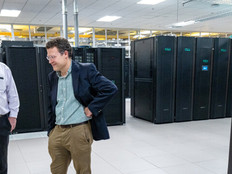Thin — but Mighty — First Response
For the past five years, the National Park Service’s Peter Paul and Don Winter have served on the Pacific Northwest National Incident Management Team 2, one of 17 incident management teams in the nation that respond to large emergencies.
Their team fights regional and national fires and has responded to some of the nation’s largest disasters in recent years, including the Sept. 11, 2001, terrorist attack on the World Trade Center, hurricanes Rita and Ivan, and the recovery operation of the Space Shuttle Columbia.
Last year, the pair of technology specialists — who spend their days maintaining systems at Mount Rainier National Forest — proposed a thin-client concept to the National Interagency Fire Center, a support center run by eight federal agencies that handles the nation’s wild-land firefighting efforts from a center in Boise, Idaho. After receiving support for the idea, the National Park Service and Forest Service bought five thin-client kits, each featuring one Windows 2003 server and five to 10 Hewlett-Packard T5520s and T5530s thin clients. Paul and Winter made up one of five teams to prototype the technology last year. The kits were used for nine fires last year, and the technology worked perfectly.
When a fire breaks out, Paul and Winter rent a pickup truck and tow a trailer full of tech equipment to the scene. The trailer houses their server, thin-client computers, networking equipment and a satellite dish that provides Internet access, as well as desk space for team members. Setting up the basic computer network, which used to take several hours, now takes less than an hour, the pair says.
The technology offers a good return on investment. In the past, the team would rent or lease computer equipment for $10,000 to $12,000 for a two-week deployment. The cost of the server and 10 thin clients in a kit pays for itself after two or three incidents, Paul says.
Team Tactics
Sometimes as many as 50 to 60 people connect to the network to manage an incident. Four or five geographic information system specialists often work around the clock, generating maps to help firefighters plan their attack. Others access incident management software, where they can order supplies and other resources.
Team members who bring their own notebooks can easily connect to the server and access applications and data by using their computers as thin-client devices. Windows-based computers come with the Remote Desktop Client installed, letting users log in and connect to the Terminal server.
Most users don’t even know they’re on a thin client, Paul says. “It has the same look and feel as any computer.”
Other benefits include centralized data and improved security. In the past, users shared data by passing USB flash drives to each other. Now, they simply access the data on the server.
Two years ago, someone stole a different team’s notebook that served as an ad-hoc network’s server during a California fire. That got Paul and Winter to think more about security. With the standardized thin-client kits, the server is housed in a rack with an uninterruptible power supply and other equipment, making it almost impossible to steal because of its weight, Winter says.
“If someone tried to get away with it, it would take four people to lift it,” he says.
Caching Kits
The network is so stable, Paul and Winter now have time to aid other team members with their tasks, such as building maps and helping with planning.
With their success, they now hope to spread the technology nationally to all incident management teams, which include about three dozen other incident management teams that handle less complex incidents.
Today, seven thin-client kits are available. The interagency teams have recently received some funding to buy additional kits this year. Their goal is to eventually reach 40 or more kits that can be stored in “fire caches” throughout the nation, so if an incident occurs, the teams can order them and have them sent to disasters along with other necessary tools, supplies and resources.
Read more about possible thin-client uses in government in this online white paper.







